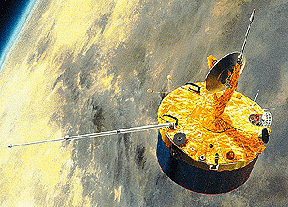|
|
Pioneer Venus Orbiter

Pioneer Venus consisted of two spacecraft to study Venus: the Orbiter
and the Multiprobe. The latter separated into 5 separate vehicles near Venus.
The Orbiter was launched on the 20 May 1978 from the Kennedy Space Center
aboard an Atlas-Centaur rocket. It went into orbit around Venus
on 4 December 1978. Its primary objective was to investigate the solar wind in
the Venusian environment, map Venus' surface through a radar imaging system,
and study the characteristics of the upper atmosphere and ionosphere.
The Orbiter carried twelve instruments, most of them dedicated to plasma
investigations of the Venusian upper atmosphere, as well as instruments for
observing reflected sunlight from the cloud layers at a variety of
wavelengths, and a surface radar mapper. There was, however, a gamma-ray
burst detector experiment added on the satellite.
Although originally intended to operate in orbit for one Venusian year, most
of the Orbiter instruments, including the gamma ray burst detector, were
still operating when the spacecraft entered the atmosphere on 8 October
1992.
The Pioneer Venus Multiprobe was launched on 8 August 1978. It encountered
Venus on 9 December 1978. It consisted of 5 separate probes: the probe
transporter (referred to as the Bus), a large atmospheric entry probe
(called Sounder), and 3 identical small probes (called North, Day, and
Night). The Sounder released from the Bus on 15 November 1978; the 3 small
probes released on 19 November 1978. All probes entered the Venusian
atmosphere within 11 minutes of each other, and descended toward the
surface over approximately an hour long period sending back data to the
Earth.
The Orbiter Gamma Burst Detector (a joint Los Alamos National Laboratory/
Sandia National Laboratory effort) was designed to record the temporal and
spectral characteristics of cosmic gamma-ray bursts.
The primary objective of the experiment was the accurate determination of the
directions to the sources of such bursts through a
technique of triangulation as a member of a widely spaced array of similar
instruments (ISEE-3, Venera-11 & 12, Helios-2). The system consisted of a pair
of scintillation spectrometers sensitive in the range of energies between 100
and 2000 keV, together with logic and data storage to
provide a capability for recording these events. The gamma ray burst detector
went into operation on 21 May 1978, one day after launch. It operated
continuously until PVO fell into Venus in 1992.
The complete system, including connecting cables, weighed 2.9 kg and
operated on 1 Watt of electrical power. The sensors were mounted at the
periphery of the Orbiter spacecraft equipment platform, diametrically
opposite each other. Thus, there was nearly uniform omnidirectional
coverage. The sensors were actively guarded scintillation photon counters,
each containing a 3.8 cm diameter x 3.2 cm long CsI scintillation crystal.
The crystal was optically bound to a 0.5 cm shell of plastic
scintillator. The composite scintillator (or phoswich) was passively
shielded from low energy radiation by a jacket of 0.25mm lead foil and the
sensor housing.
In the absence of a gamma ray event, the instrument operated in a real time
background mode. These data included background count rates, spectra, state
of health information, and source calibration. The background spectral
information was taken in 4 energy channels. Events were determined by a
statistically significant increase in counting rate. Since it is important to
see the beginning of a burst, a pre-trigger memory was included. The data
stream was continuously routed to the pretrigger memory, which kept it for
about 3 seconds. In background mode, the oldest data were continuously
replaced by newer data. However, once a trigger occurred, the contents of the
pretrigger memory were transferred to the main memory. In this way, the onset
of an event was recorded even though it occurred before the event was
recognized by the system. The event data were accumulated into 5 energy
channels. Channel 1 covered the energy range 0.1-2.0 MeV. Channels 2-5
were defined by thresholds at 0.1, 0.2, 0.5, 1.0,and 2.0 MeV. The normal
accumulation time for Channel 1 was 11.7 ms, although 0.25 ms resolution
was achievable.
" A search of the Pioneer Venus Orbiter (PVO) Gamma Burst Detector real time
data was carried out to identify and study the characteristics of celestial
gamma ray bursts (Chuang 1992). Each of the 5 channels of the detector were
analyzed to determine the time width, rise time, and hardness ratio of the
bursts. Two hundred seventeen new cosmic gamma ray bursts and 126 solar flares,
not detected by the PVO gamma ray burst detector in the trigger mode, were
found (source reference Ph.D. thesis Chuang Kuan-Wen)"
The homogeneity of the burst source population in space was studied on the
basis of a sample of 225 observed gamma-ray bursts between September 1978 and
July 1988 from the Pioneer Venus Orbiter. The results were consistent with a
uniform distribution in space of the parent population of burst sources.
A PVO gamma-ray burst catalog was published (Chuang 1990). This catalog gives
information on the triggered events detected by the PVO instrument
from 9/14/78 to 7/21/88.
[Gallery]
[Publications]
[NSSDC PVO Archive]
[HEASARC PVO Catalog]
[All Missions]
[by Time]
[by Energy]
Page authors: Lorella Angelini Jesse Allen
HEASARC Home |
Observatories |
Archive |
Calibration |
Software |
Tools |
Students/Teachers/Public
Last modified: Thursday, 24-Sep-2020 17:37:05 EDT
|


